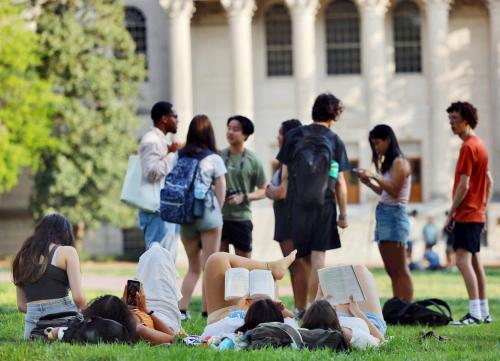Why do many college-intending, low-income students not complete applications for financial aid? For decades, stakeholders have argued financial aid applications, especially the Free Application for Federal Student Aid (FAFSA), are too complex and pose a significant barrier to college access and completion.
There have been tremendous efforts to simplify financial aid access for both state and federal aid programs recently, most notably the FAFSA Simplification Act of 2020. Starting this application cycle, the FAFSA Simplification Act will bring many improvements to federal and state aid access — a shorter form, syncing up data with the IRS, and increasing the number of students eligible for Pell grants. However, the rollout of the new FAFSA this year has been fraught with challenges.
Cascading delays in FAFSA rollout
First, the new form was delayed. Students can typically start the FAFSA on October 1 (a shift made in 2016 to give students more time to complete the form — research suggests that date change increased applications for both new and returning students). Due to the technical complexity of updating the form, though, the Department of Education told students the application wouldn’t open until December 2023. While that was technically correct, the FAFSA’s “soft launch” on December 31 left many families frustrated as the website was only open sporadic hours each day and not consistently available until early January.
Now, the Department of Education has warned colleges they won’t receive students’ financial aid information until at least March, months later than usual. Part of this delay is because the Department needed to fix an earlier error that failed to account for inflation in how students’ aid gets calculated. The correction is important — likely increasing available Pell grant aid by $1.8 billion — but the delay pushes back the overall college decision timeline.
These delays leave a set of cascading problems in their wake. Colleges can’t process financial aid packages for admitted students until they have their FAFSA data. States often use the FAFSA to award state aid, which in most years reduces administrative burden for accessing state scholarships, but this year could slow down state aid processing. Most students can’t decide where to enroll without information about how much college will cost, including how much aid they have access to.
In addition to critiques about the implementation of the new FAFSA, there are substantive changes to the form that will persist in future years and necessitate additional support to students and families. For example, while an easier form for many students to complete, the new process requires student applicants and at least one parent to have an online FAFSA account (“FSA ID”). Getting that FAFSA account requires each of those individuals to have an email address and a social security number. Students whose parents are undocumented must navigate a complex identify verification process (which is not yet working this year). Families with low technology access may also struggle to set up email accounts and complete the application online (and the federal Affordable Connectivity Program that provides free broadband internet to low-income households is sunsetting this spring).
There have been multiple theories put forth about why the FAFSA rollout this year was so rocky. Democrats argue the Federal Student Aid office was “flat funded” in the 2023 budget negotiations, resulting in lower agency capacity to implement the new FAFSA. Republicans argue the agency has been too busy implementing student loan forgiveness to focus on the FAFSA. Regardless of why the implementation has been so challenging, the question now turns to how to support students accessing financial aid to support their college aspirations through spring 2024 and beyond.
School counselors are a vital resource to financial aid access
School counselors are on the front lines of supporting students and families through this year’s FAFSA rollout, as The Chronicle of Higher Education recently highlighted. This year’s National School Counseling Week is a reminder of the vital role school counselors are playing and will continue to play in supporting students’ postsecondary dreams, including navigating complex financial aid forms.
In a recent paper, my co-author Elizabeth Bell and I found that hiring more school counselors significantly increases students’ financial aid receipt. Our analysis leveraged an Oklahoma state law that mandates high schools hire one counselor for every 450 students. Our analysis used a regression discontinuity design focused on schools just above and below the 450-student enrollment threshold, to see if going from one to two mandated school counselors made a difference for students. Our prior work found that in states with these school counselor staffing rules, school counselors tend to have smaller caseloads and can theoretically spend more time guiding students through high school and beyond.
In Oklahoma, we found schools just above the 450-student mark employed 0.16-0.26 FTE more counselors — which left school counselors with about 40 to 80 fewer students to serve. How did counselors use that additional time? Our analysis suggests they were able to help more students access state and federal financial aid. Schools with more counselors had more students receiving the Pell grant and the state Oklahoma Promise scholarship. This was especially true in more recent years when the Oklahoma Promise scholarship application became increasingly more complex and difficult to navigate. Our research also found the increase in Pell receipt was larger for Black, Hispanic, and Native students. This work echoes other research finding school counselors matter for postsecondary access, including one study finding schools with additional counselors have higher college-going rates and other work finding high-performing school counselors significantly increase the likelihood low-income and low-achieving students graduate high school and go to college.
Solutions to support financial aid access, this year and beyond
How can schools, colleges, and states work together to support students through FAFSA completion, this year and beyond?
- Schools should prioritize school counselors’ duties to supporting FAFSA completions
At this point, schools can’t simply hire more school counselors to navigate the spring 2024 FAFSA process. However, they can reallocate school counselor duties to free up more time to support students and families. Particularly in the wake of the COVID-19 pandemic, many counselors reported an increase in “extra duties” such as taking on substitute teaching responsibilities or covering lunch duty. These duties should be offloaded to other staff to enable counselors to perform the job they alone can do. In the long-term, state legislation around recommended or required student-counselor ratios are associated with students having access to more school counselors, and additional funding could expand school support staff so school counselors can focus on advising students and families. Districts will need to balance this need for adequate student support staff with the end of ESSER funding and anticipated slowing state revenues.
- States should extend scholarship application deadlines and relax FAFSA graduation requirements
Many states require students to file the FAFSA by early- or mid-spring for state scholarships. Research indicates that earlier deadlines are associated with the lowest income students being less likely to receive a state grant, as they may struggle to complete the FAFSA before state deadlines. States should push back the priority FAFSA deadlines to later in the spring to account for this year’s slow form rollout. Some states have already done so. For example, the Tennessee Promise scholarship typically requires students to complete the FAFSA by March 1 — the state initially changed the deadline to April 15 for this year and recently shifted that deadline even further back to May 15.
The official listing of state FAFSA filing deadlines suggests few other states have followed suit. There are 53 state programs (states have multiple scholarship programs) that list a priority FAFSA application date in 2023 or 2024. Of those 53 dates, 34 are identical across 2023 and 2024, and another 12 only shifted their “ASAP” notes to “ASAP after December 31” to reflect when the FAFSA was released. Two DC programs initially posted earlier deadlines in 2024 than 2023, though recently announced pushing deadlines later. Only five programs (in California, Tennessee, and Texas) pushed their 2024 deadline back in a meaningful way. Even if states have subsequently pushed back their deadlines since posting them on the FAFSA form (e.g., DC, Tennessee), many students will rely on the official deadlines listed on the FSA website, and states that do shift their deadlines will need to work with school counselors and college access organizations to spread the word.
Many states also require students to complete the FAFSA as a graduation requirement — 12 states currently mandate high school seniors complete the FAFSA and several others have pending legislation. While schools should continue to encourage high FAFSA completion rates, there should also be increased flexibility in the opt-out process this year for students unable to complete the form before graduation.
- Colleges should push back decision day until June 1
Colleges typically ask students to either accept or reject admissions offers by May 1 — historically celebrated as “decision day.” However, if colleges do not receive student aid data until March, there will not be enough time for colleges to package aid, share that information with students, and give students enough time to compare their options. Colleges should move their decision deadlines back to June 1 at the earliest. Of course, this has implications for how colleges will plan their fall semesters. Colleges ask students to commit by May 1 for a reason, so they have time to assign students to housing, hire any additional instructional staff, and orient students to college. Many students experience “summer melt” in the summer between high school and college as they struggle to complete all the enrollment tasks on time, and a compressed timeline could make it more difficult to ensure admitted students are able to start in the fall. The cascading effect of the FAFSA delay will be felt by colleges and students well into the fall of 2024.
Next year, the FAFSA process should (hopefully) be smoother, finally delivering on the promise of the FAFSA Simplification Act and expanding college access and affordability. Now that the underlying technology of the online FAFSA has been updated, it should be released on time in October 2024. Until then, though, it’s all hands on deck to help ensure college-intending students this spring are not derailed from attending college due to the form’s rocky rollout.
The Brookings Institution is committed to quality, independence, and impact.
We are supported by a diverse array of funders. In line with our values and policies, each Brookings publication represents the sole views of its author(s).








Commentary
School counselors are vital to navigating the FAFSA maze
February 6, 2024